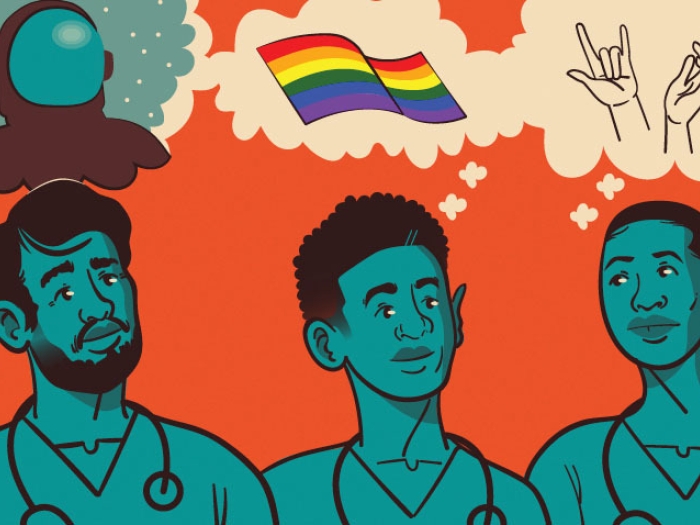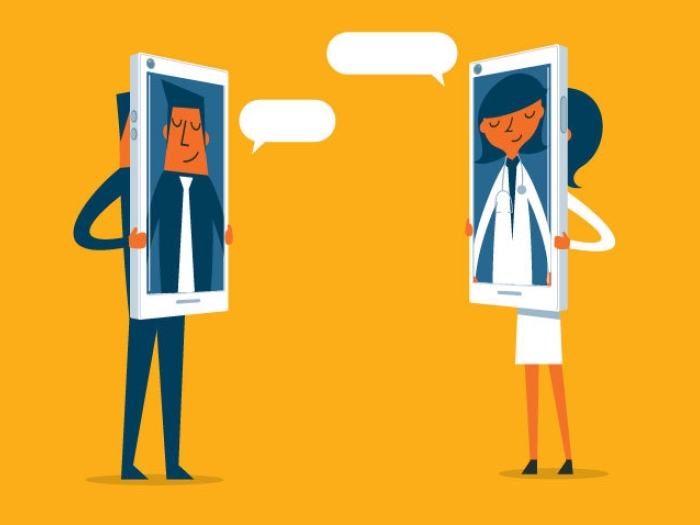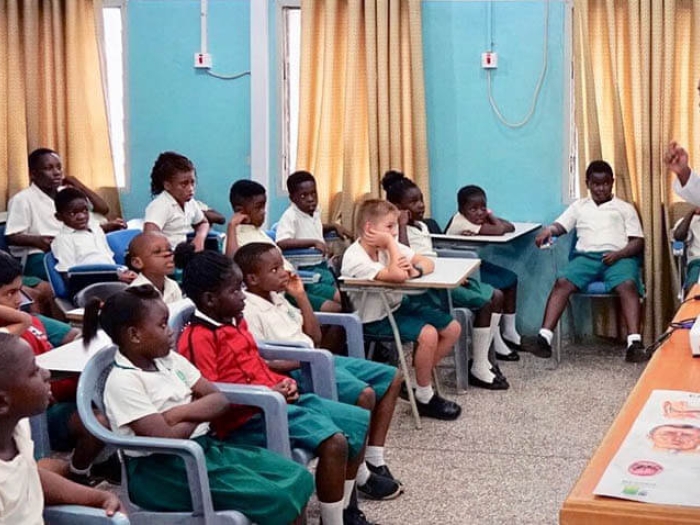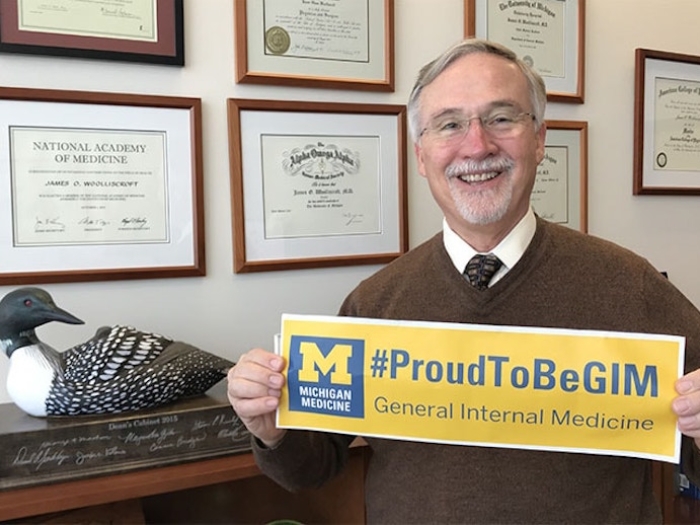New research on U-M’s Doctors of Tomorrow initiative finds lessons relevant to other institutions seeking to create a more diverse medical student pipeline.
1:00 PM
Author |
When it comes to helping young people succeed, a range of formal and informal mentoring is key.
Not just because of the knowledge and skills students can learn from mentors, but also because mentoring provides professional socialization and personal support.
MORE FROM THE LAB: Subscribe to our weekly newsletter
But mentoring is not a one-way street reserved for experienced workers handing down their wisdom to those just starting out. People of all ages can benefit from, and provide, mentorship.
Take near-peer mentor relationships, which partner people close in social, professional or age level.
To gauge such relationships' effect on promoting careers in the health care industry to underrepresented minorities, Adrianne Haggins, M.D., evaluated the Doctors of Tomorrow program, an innovative project that pairs first-year medical school student mentors from the University of Michigan with freshmen from Cass Technical High School in Detroit.
What she found: mutually beneficial relationships with common themes leading to success.
"Beyond looking at mentorship broadly, this study allowed us to look more granularly at why these relationships were successful," says Haggins. "We were able to capture the high school students' and medical students' voices as to why they found the relationships valuable and get both groups' perspective."

Pipeline for diversity
Jonathan F. Finks, M.D., associate professor of surgery and co-director of the Michigan Bariatric Surgery Collaborative, started Doctors of Tomorrow to inspire high school students from underrepresented communities to pursue careers in health care.
SEE ALSO: What the Michigan Med School Admissions Team Looks for on Applications
Through a yearlong curriculum, the high school students take part in hands-on clinical exercises, academic preparation and professional development sessions, and complete a capstone project. The medical students, who must meet in person with their mentee at least seven times during the year, also participate in professional development activities that focus on mentorship skills and unconscious bias training.
Finks founded the program in 2012 in partnership with Cass Tech, which has a student body that is about 90 percent African-American.
Racial and ethnic minorities are projected to represent 50 percent of the U.S. population by 2050, according to the Association of American Medical Colleges. But as of 2015, African-Americans, Mexican-Americans, mainland Puerto Ricans and American Indians continue to be underrepresented in medicine relative to their proportions in the population.
"Despite the wealth of talented young people from Detroit, very few faculty, residents or medical students at the University of Michigan are from Detroit," says Finks.

The impact
Haggins, an assistant professor of emergency medicine with research interests in health care disparities, collected data from fall 2014 through spring 2016 to evaluate a cohort of the Doctors of Tomorrow program. She facilitated a series of focus groups and individual interviews and assessed written responses in which both partners were asked to describe the experience.
Seventy medical students and 52 high school students voluntarily participated in the study.
Haggins says her study, which was published in the Journal of the National Medical Association, reveals three important themes. High school student mentees and mentors valued their near-peer mentorship relationships based on regular in-person and electronic contact, shared common interests and the length of the program.
"Many of the high school students noted that they were aware of their mentors' rigorous schedules, so they felt their mentors genuinely cared for them by choosing to devote time to them," says Haggins.
In addition to the in-person meetings, the high school students indicated they appreciated staying connected with their mentors via text messages and email — forms of communication that were not as time-consuming but still had a significant impact.
Haggins also explained that when mentors and mentees found mutual personal interests, it enhanced the relationship.
By sharing personal aspects, participants found common ground and ways to relate to one another. As familiarity between the high school and medial students improved, the more fondness and enjoyment they gained from their interactions.
Since the program's inception, Doctors of Tomorrow has significantly expanded. DoT Rising launched in 2015 and gives students in 10th through 12th grades continued mentorship opportunities and exposure to the medical field through after-school clinical skills sessions, leadership opportunities and professional development.
The cohort of high school students who were a part of the pilot group in 2012 are now freshmen at various universities, including U-M. The U-M freshmen have started DoT Succeed, which gives the now-first-year undergraduate students the opportunity to connect with medical students to discuss real-life problems that they face, such as stress, time management and how to network.
This is an opportunity to take medical students out of their environment and potentially break down some of the stereotypes they may have.Adrianne Haggins, M.D.
Mutual benefit
Doctors of Tomorrow set out to encourage younger students to explore careers in health care.
But as Haggins' work shows, medical students greatly benefit as well.
SEE ALSO: A Win-Win for Science Education: Postdocs in Community College Classrooms
She says medical school students, who disproportionately come from wealthier areas with family members who have achieved high levels of academic and career success, gain from building relationships with students who may have grown up differently.
"This is an opportunity to take medical students out of their environment and potentially break down some of the stereotypes they may have," says Haggins. "It gives them insight of the talent and drive of these high school students who come from backgrounds different than their own."
Haggins' data also show the medical students' drive and motivation were maintained or reinforced because of their roles as mentors.
One survey respondent wrote, "working with the students each month consistently re-energized me and reiterated why I chose to go into medicine in the first place."

Next steps
Haggins' results were presented during the Association of American Medical Colleges' annual meeting, Learn Serve Lead 2017. She would like her findings to inform her peers and colleagues from other institutions who are looking to create pipeline programs.
She says she will continue to produce scholarly work that focuses on not only exposing underrepresented minority students to the health care industry, but also which resources and infrastructure should be in place once they reach college.
"What happens when these students get on a college campus?" she says. "I want to look at what influences and resource helps them to remain on that pre-med pathway."
Photos by Leisa Thompson

Explore a variety of healthcare news & stories by visiting the Health Lab home page for more articles.

Department of Communication at Michigan Medicine
Want top health & research news weekly? Sign up for Health Lab’s newsletters today!





